In honor of Diwali, we take a look back at the Elementary classes' celebration last year... An important tenet of Montessori philosophy is the recognition of all of humanity as a part of a global family. The "global citizen" aspect of Montessori values the wide and beautiful tapestry of ethnic and cultural backgrounds, and takes seriously the responsibility of raising our children to be open-minded and open-hearted. Part of this practice begins with introducing them to people from different cultures and ethnic backgrounds, as well as the celebrations of such groups. On October 19th, the Diwali Hindu festival of lights began. Villa di Maria's Elementary students were eager to celebrate.
An important tenet of Montessori philosophy is the recognition of all of humanity as a part of a global family. The "global citizen" aspect of Montessori values the wide and beautiful tapestry of ethnic and cultural backgrounds, and takes seriously the responsibility of raising our children to be open-minded and open-hearted. Part of this practice begins with introducing them to people from different cultures and ethnic backgrounds, as well as the celebrations of such groups. On October 19th, the Diwali Hindu festival of lights began. Villa di Maria's Elementary students were eager to celebrate.
 Diwali is India's most important holiday of the year; it is as important to Hindus as Christmas is to Christians. The festival of lights (which occurs over the course of five days) symbolizes the inner light that protects from spiritual darkness, and occurs every autumn. Over the centuries, Diwali has become a national festival that is celebrated by most Indians, regardless of their faith, and most accurately represents the victory of good over evil.
Diwali is India's most important holiday of the year; it is as important to Hindus as Christmas is to Christians. The festival of lights (which occurs over the course of five days) symbolizes the inner light that protects from spiritual darkness, and occurs every autumn. Over the centuries, Diwali has become a national festival that is celebrated by most Indians, regardless of their faith, and most accurately represents the victory of good over evil. The entire elementary gathered together to celebrate Diwali last week. Alongside several students who played, drummed, and sang, Upper Elementary Directress Rebecca Callander performed the Hindu song, "Listen to My Old Soul Song" for the group. The song came together so nicely, with the children and Rebecca working together during the performance.
The entire elementary gathered together to celebrate Diwali last week. Alongside several students who played, drummed, and sang, Upper Elementary Directress Rebecca Callander performed the Hindu song, "Listen to My Old Soul Song" for the group. The song came together so nicely, with the children and Rebecca working together during the performance. The word Diwali is derived from the Sanskrit word "deepavali," meaning "series of lighted lamps." The children lit a number of candles to represent the return of the deities Rama and Sita after their 14 years of exile; in the story, the villagers lit oil lamps to illuminate the path through the darkness. The lights also celebrate Lakshmi, the goddess of wealth and prosperity.
The word Diwali is derived from the Sanskrit word "deepavali," meaning "series of lighted lamps." The children lit a number of candles to represent the return of the deities Rama and Sita after their 14 years of exile; in the story, the villagers lit oil lamps to illuminate the path through the darkness. The lights also celebrate Lakshmi, the goddess of wealth and prosperity.



An image of the Demon King Ravana

Goddess Lakshmi, painted by Raja Ravi Varma in 1896

Lower Elementary Directress Anna Schwind presented the Diwali story to the children, split into two groups, with much enthusiasm. She always has a captive audience, and is truly a gifted storyteller. Here, she retold and acted out the story of Ramayana, in which Lord Rama rescues his wife Sita from the Demon King Ravana, who happens to have twenty arms and ten heads!


After the the story of Diwali, the children headed outside to the pavilion, where an activity awaited them!

Lower Elementary Directress Megan Eilers had set up a rangoli activity for the children to complete. Rangoli, a colorful design made on the floor near the entrance of one's home, is meant to welcome guests and encourage the goddess Lakshmi to enter. Rangoli can be made from chalk, colored rice, flour, sand, or even flower petals. Here, the children worked with cardboard patterns with sticker designs and sand. Many of them chose to take their patterns home to finish later, as it was a long and involved (and enjoyable) process!





The results were beautiful!

While one group enjoyed rangoli, the other was treated to a short meditation lead by Upper Elementary Directress Rebecca Callander.






The children were also encouraged to try several traditional Indian treats, included mango drink, crushed peanut chikki squares, till laddoo (sesame brittle), muruku (rice snacks), jalebi, and apple slices.
In the Montessori tradition, children are guided beyond just acceptance of multicultural ideas; through their cultural, hands-on studies, they are shown to understand, appreciate, respect, and celebrate many cultures so that they may come alive in the child's mind.All of the photo and writing credit goes to the ever talented Lauren Knight.
 In Montessori we talk a lot about individuality. Children working at their own pace, children being met where they are, children learning through topics that interest them... But, collaboration is vital to any community's success and a crucial life skill for individuals.
In Montessori we talk a lot about individuality. Children working at their own pace, children being met where they are, children learning through topics that interest them... But, collaboration is vital to any community's success and a crucial life skill for individuals.
 Opportunities to practice teamwork - hand in hand with opportunities to practice negotiating the difficulties that can arise when working with others - are omnipresent in the Montessori environment. These experiences and the tools that children gain from them, prepare children for life beyond school.
Opportunities to practice teamwork - hand in hand with opportunities to practice negotiating the difficulties that can arise when working with others - are omnipresent in the Montessori environment. These experiences and the tools that children gain from them, prepare children for life beyond school.




 From carrying heavy objects to research to experiments, teamwork makes the dream work! We know this for our children, and we see it in our greater Villa di Maria community. Thank you for being part of our team!Photo credit to Jessie Braud and Melinda Smith.
From carrying heavy objects to research to experiments, teamwork makes the dream work! We know this for our children, and we see it in our greater Villa di Maria community. Thank you for being part of our team!Photo credit to Jessie Braud and Melinda Smith.

 Subbing is never easy work, and Ms. Brea did it with aplomb. She worked closely with Ms. Megan. This ensured a smooth transition for the children as well as keeping a conscientious teacher at ease.
Subbing is never easy work, and Ms. Brea did it with aplomb. She worked closely with Ms. Megan. This ensured a smooth transition for the children as well as keeping a conscientious teacher at ease.
 Ms. Brea fit in with the staff, helped with "outside of the school day" events, brought dance to our Elementary children and was (of course!) beloved by the Checkerboard children in particular. She is observant - so important for a Montessori teacher! - and insightful. She gave lessons, sparked research and deftly guided the social work in the Checkerboard classroom.
Ms. Brea fit in with the staff, helped with "outside of the school day" events, brought dance to our Elementary children and was (of course!) beloved by the Checkerboard children in particular. She is observant - so important for a Montessori teacher! - and insightful. She gave lessons, sparked research and deftly guided the social work in the Checkerboard classroom.



 There is much to be said for the Guide and Assistant relationship which supports the work of the entire classroom. Ms. Brea and Ms. Sophie worked together brilliantly. Thank you, Brea for coming to St. Louis to be with us. You have made our - and in particular, our children's - year richer by your presence. We sincerely hope that your path crosses with Villa di Maria's again in the future!Here's a peek at Checkerboard students working on a thank you project for Ms. Brea!
There is much to be said for the Guide and Assistant relationship which supports the work of the entire classroom. Ms. Brea and Ms. Sophie worked together brilliantly. Thank you, Brea for coming to St. Louis to be with us. You have made our - and in particular, our children's - year richer by your presence. We sincerely hope that your path crosses with Villa di Maria's again in the future!Here's a peek at Checkerboard students working on a thank you project for Ms. Brea!

 Ms. Brea, you will be missed!Melinda, thanks to you for these beautiful pictures highlighting Ms. Brea's role in our Elementary environment!
Ms. Brea, you will be missed!Melinda, thanks to you for these beautiful pictures highlighting Ms. Brea's role in our Elementary environment!
 This past weekend, however, parents had the opportunity to see the classroom in a whole new way. They explored the classroom without children, turning their focus on the materials themselves. The weekend provided a time lapse of all Villa di Maria offers, introducing parents to work of young children through the work of the Upper Elementary children.
This past weekend, however, parents had the opportunity to see the classroom in a whole new way. They explored the classroom without children, turning their focus on the materials themselves. The weekend provided a time lapse of all Villa di Maria offers, introducing parents to work of young children through the work of the Upper Elementary children.
 After silently walking through a classroom from each level (Parent Child, Children's House, Lower Elementary, Upper Elementary) and taking time to discuss as a group what they noticed in each of the classrooms, parents were invited to explore the environments more fully.Materials were laid out with instructions so that the parents could explore the work and follow the steps a child would follow doing the work. Other work was introduced through lessons. It's a real treat at any age to receive a lesson from a Guide!
After silently walking through a classroom from each level (Parent Child, Children's House, Lower Elementary, Upper Elementary) and taking time to discuss as a group what they noticed in each of the classrooms, parents were invited to explore the environments more fully.Materials were laid out with instructions so that the parents could explore the work and follow the steps a child would follow doing the work. Other work was introduced through lessons. It's a real treat at any age to receive a lesson from a Guide! While adults can't have the same experience that children have in the prepared environments, this is about as close as we can get to recreating our children's experience.
While adults can't have the same experience that children have in the prepared environments, this is about as close as we can get to recreating our children's experience.












 Parents left with a newfound appreciation for the work their children do at school, commenting that they would now go through their children's work folders with reverence.On the experience, one parent shared, "The objective is to experience the gift we are giving our children, and increasing our own understanding of the Montessori way. Seeing how the "lessons" have layers of concepts and teachings that take years to peel back. At the end, just when you think you "get it," like a great novel, you realize that all the activities are interconnected in a symphony of learning, spanning from when the children enter, to when they leave. Yep, you missed it the first time through. It's so subtle, you can't really explain it. How would you explain Mozart to someone who's never heard it?"This opportunity is made available once a year. If you missed it this time, look out for it next year; it's well worth your time!Thanks to Jade Venditte for sharing pictures, to the staff and supporters of Villa di Maria for making this happen and to the parents who took a chunk of their time to understand more fully what they are giving their children with the gift of Montessori.
Parents left with a newfound appreciation for the work their children do at school, commenting that they would now go through their children's work folders with reverence.On the experience, one parent shared, "The objective is to experience the gift we are giving our children, and increasing our own understanding of the Montessori way. Seeing how the "lessons" have layers of concepts and teachings that take years to peel back. At the end, just when you think you "get it," like a great novel, you realize that all the activities are interconnected in a symphony of learning, spanning from when the children enter, to when they leave. Yep, you missed it the first time through. It's so subtle, you can't really explain it. How would you explain Mozart to someone who's never heard it?"This opportunity is made available once a year. If you missed it this time, look out for it next year; it's well worth your time!Thanks to Jade Venditte for sharing pictures, to the staff and supporters of Villa di Maria for making this happen and to the parents who took a chunk of their time to understand more fully what they are giving their children with the gift of Montessori.

 While everyone made the most of the snow and cold weather, the warmer weather is beyond welcome!
While everyone made the most of the snow and cold weather, the warmer weather is beyond welcome! Extended Day is enjoying their treat of playing in the tree just outside the playground. This is a magical place... just beginning to move from the Children's House playground but not quite to the Elementary space.
Extended Day is enjoying their treat of playing in the tree just outside the playground. This is a magical place... just beginning to move from the Children's House playground but not quite to the Elementary space.

 Forts continue to be built and rebuilt.
Forts continue to be built and rebuilt. Appropriately, this fort is building a patio! Who doesn't want to spend a Spring day on the patio?
Appropriately, this fort is building a patio! Who doesn't want to spend a Spring day on the patio? Stone gathering for the patio.
Stone gathering for the patio. There are pretty high standards for the sticks used in some of the forts!
There are pretty high standards for the sticks used in some of the forts! Epic games of Ultimate Frisbee are underway.
Epic games of Ultimate Frisbee are underway.

 And lots and lots of tree climbing!
And lots and lots of tree climbing! Spring will continue to be enjoyed in all of its states so make sure your child has a change of clothes (Elementary as well as Children House - these children play hard in the mud!), boots and raincoats when appropriate. Happy Spring!
Spring will continue to be enjoyed in all of its states so make sure your child has a change of clothes (Elementary as well as Children House - these children play hard in the mud!), boots and raincoats when appropriate. Happy Spring!





 The younger children were then invited to a sensorial experience of the drums at hand!
The younger children were then invited to a sensorial experience of the drums at hand!
 The bus trip is admittedly always a highlight of these adventures.
The bus trip is admittedly always a highlight of these adventures. The performance itself received rave reviews from children and adults alike!
The performance itself received rave reviews from children and adults alike!

 Children and adults from each class were invited to join the group on stage to learn a dance.
Children and adults from each class were invited to join the group on stage to learn a dance.

 What a morning for our Extended Day children!
What a morning for our Extended Day children! While Extended Day children boarded buses back to school, the Elementary children continued their adventure with a trip to Ikea for lunch! This was a real Practical Life work - managing money, choosing items, navigating the cafeteria and of course eating with friends!
While Extended Day children boarded buses back to school, the Elementary children continued their adventure with a trip to Ikea for lunch! This was a real Practical Life work - managing money, choosing items, navigating the cafeteria and of course eating with friends!

 Melinda Smith shared the joy of the day with us through her photographs. Thank you Melinda!
Melinda Smith shared the joy of the day with us through her photographs. Thank you Melinda!






 As usual, Melinda Smith brings light to the darkness. Thank you for the photographs, Melinda.
As usual, Melinda Smith brings light to the darkness. Thank you for the photographs, Melinda.
 Assessments are only helpful if they give information which is valid and accurate. Surely many of us can relate to the experience of doing well on a test but not truly understanding the information tested. So, unlike traditional models, assessment in Montessori classrooms provides real feedback to the guide - and the child - about their understanding.The child is frequently assessed by their guide through direct interaction and observation. This one-on-one consideration allows the guide concrete understanding of where a child is, what they understand and where any gaps in knowledge might be.
Assessments are only helpful if they give information which is valid and accurate. Surely many of us can relate to the experience of doing well on a test but not truly understanding the information tested. So, unlike traditional models, assessment in Montessori classrooms provides real feedback to the guide - and the child - about their understanding.The child is frequently assessed by their guide through direct interaction and observation. This one-on-one consideration allows the guide concrete understanding of where a child is, what they understand and where any gaps in knowledge might be. Moreover, the children are given the skills to self-assess - to determine for themselves where they need more practice, where they went wrong, what they need to do to succeed. This work is not done in a vacuum; the guide works on the skill of self-assessment with the child. In the Elementary classroom this work can concretely be seen during weekly conferences although in reality the work is done every day. This is true not just of academic feats but also of social and emotional endeavors.
Moreover, the children are given the skills to self-assess - to determine for themselves where they need more practice, where they went wrong, what they need to do to succeed. This work is not done in a vacuum; the guide works on the skill of self-assessment with the child. In the Elementary classroom this work can concretely be seen during weekly conferences although in reality the work is done every day. This is true not just of academic feats but also of social and emotional endeavors. Testing in the more traditional sense is, however, a reality of our world. And as test-taking is a skill in and of itself, it is something we want to give the children some experience with. And so, at the beginning of March our 3rd through 6th year students will embark on a week of standardized testing after spending time at the end February prepping for the experience. For those with 3rd years, please know that this is a rite of passage that is generally greeted with excitement and eager anticipation!As this type of test is divergent from the experiences most Montessori children are familiar with, the message that we send our children about it is important and formative.To that end, we ask that you encourage your children to do their best without unnecessarily weighting the outcomes. From our perspective, this test gives them practice and exposure to the types of standardized tests which they may be taking in the future. It does not necessarily mean one thing or another about them academically. It has gravity and importance, but it does not (and cannot) reflect the fullness of their intellect or ability.
Testing in the more traditional sense is, however, a reality of our world. And as test-taking is a skill in and of itself, it is something we want to give the children some experience with. And so, at the beginning of March our 3rd through 6th year students will embark on a week of standardized testing after spending time at the end February prepping for the experience. For those with 3rd years, please know that this is a rite of passage that is generally greeted with excitement and eager anticipation!As this type of test is divergent from the experiences most Montessori children are familiar with, the message that we send our children about it is important and formative.To that end, we ask that you encourage your children to do their best without unnecessarily weighting the outcomes. From our perspective, this test gives them practice and exposure to the types of standardized tests which they may be taking in the future. It does not necessarily mean one thing or another about them academically. It has gravity and importance, but it does not (and cannot) reflect the fullness of their intellect or ability. Finally, when you receive your child's scores in the next few months, please refrain from sharing the results with them. This information is not helpful to your child, and it is difficult to share scores with children without giving them false import. Remember that while the scores may be helpful on a macro level (e.g., providing feedback to guides regarding class-wide strengths or weaknesses), the scores are taken out of any meaningful context for children. The children may try to contextualize their numbers by comparing them with classmates which is, as you can imagine, beneficial to no one. The social nature of Elementary children, coupled with the novelty of test scores, lead us to ask the community as a whole to refrain from sharing test results with children.
Finally, when you receive your child's scores in the next few months, please refrain from sharing the results with them. This information is not helpful to your child, and it is difficult to share scores with children without giving them false import. Remember that while the scores may be helpful on a macro level (e.g., providing feedback to guides regarding class-wide strengths or weaknesses), the scores are taken out of any meaningful context for children. The children may try to contextualize their numbers by comparing them with classmates which is, as you can imagine, beneficial to no one. The social nature of Elementary children, coupled with the novelty of test scores, lead us to ask the community as a whole to refrain from sharing test results with children. The important parenting work surrounding the test taking experience is to reassure your child that while you want them to do their best and try their hardest, you love them anyway, no matter what. Make sure that they know that the test does not prove or disprove anything about them as people. And finally, to support the entirety of the experience, make sure they are well-rested, well-fed and unscreened the morning of testing.My thanks to Anna Schwind for many, many of the above words along with lots of insights (as always!). The brilliance of the photography comes from Melinda Smith and Lauren Knight.
The important parenting work surrounding the test taking experience is to reassure your child that while you want them to do their best and try their hardest, you love them anyway, no matter what. Make sure that they know that the test does not prove or disprove anything about them as people. And finally, to support the entirety of the experience, make sure they are well-rested, well-fed and unscreened the morning of testing.My thanks to Anna Schwind for many, many of the above words along with lots of insights (as always!). The brilliance of the photography comes from Melinda Smith and Lauren Knight.
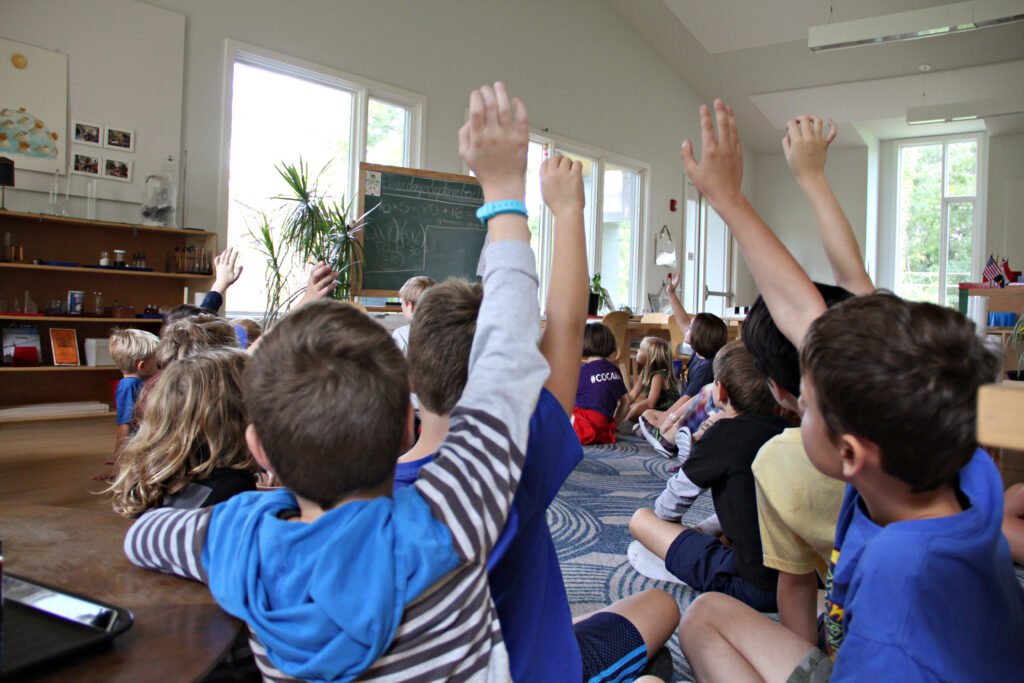 Welcome to the second part of the series on creating community together. The previous
Welcome to the second part of the series on creating community together. The previous 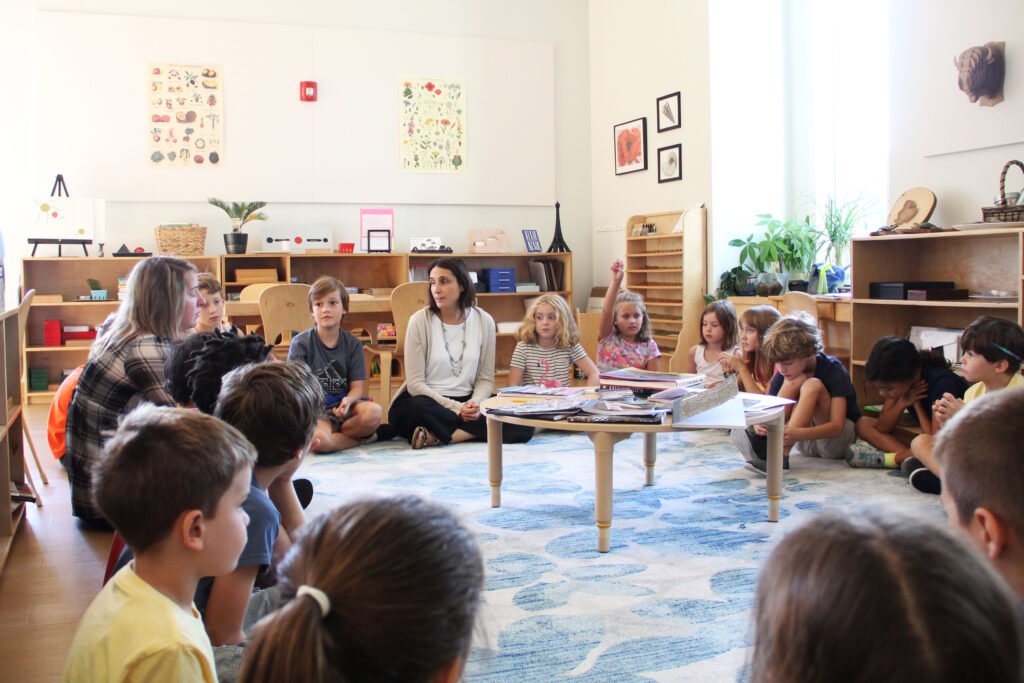
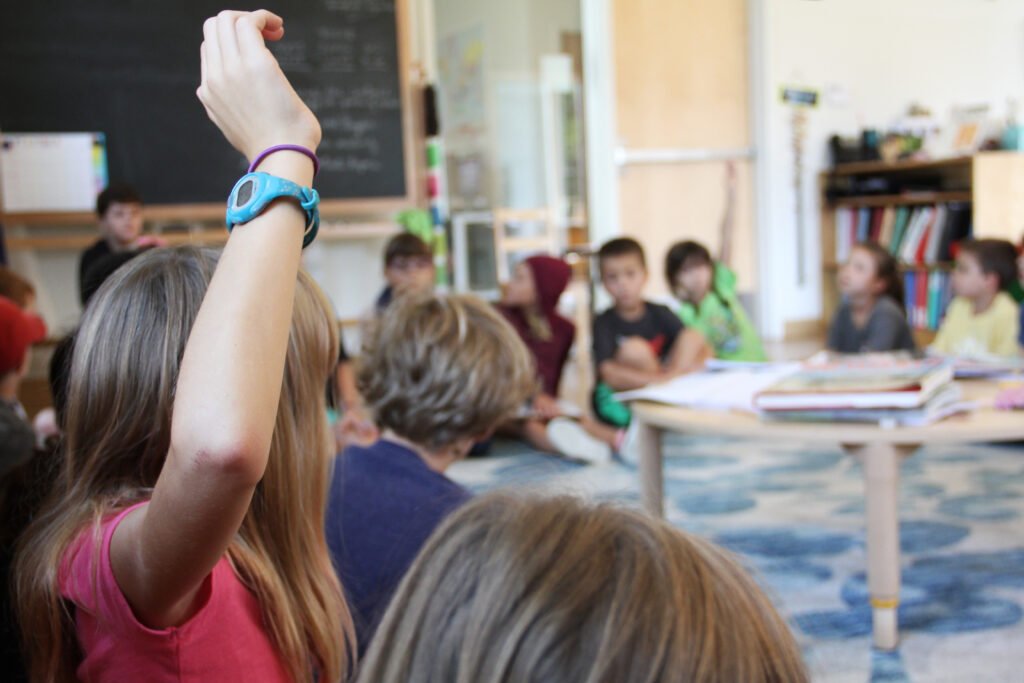
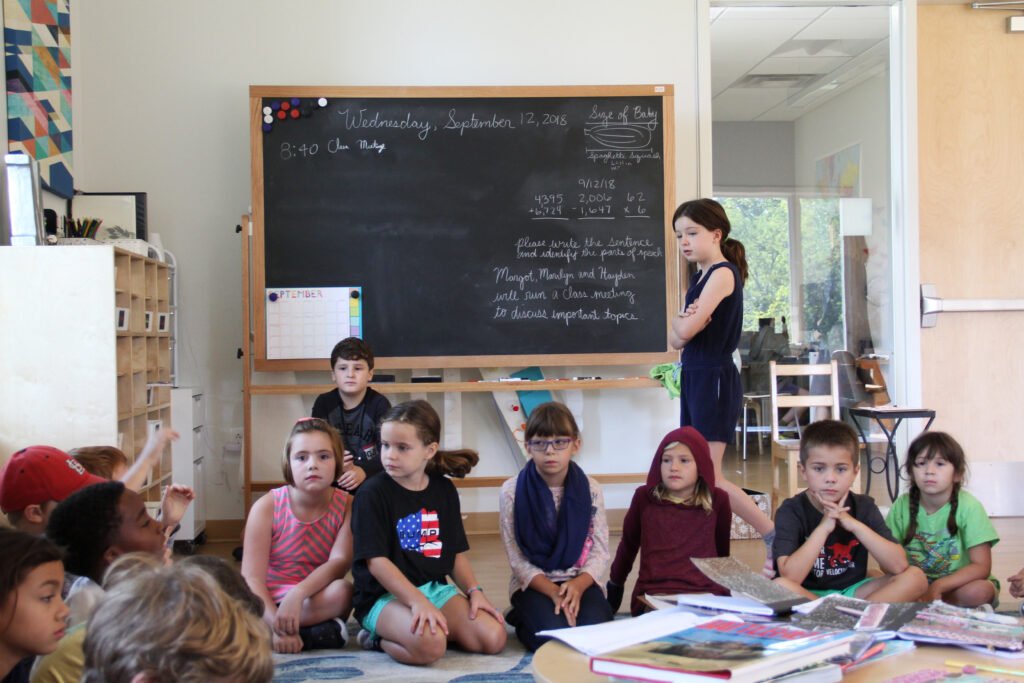

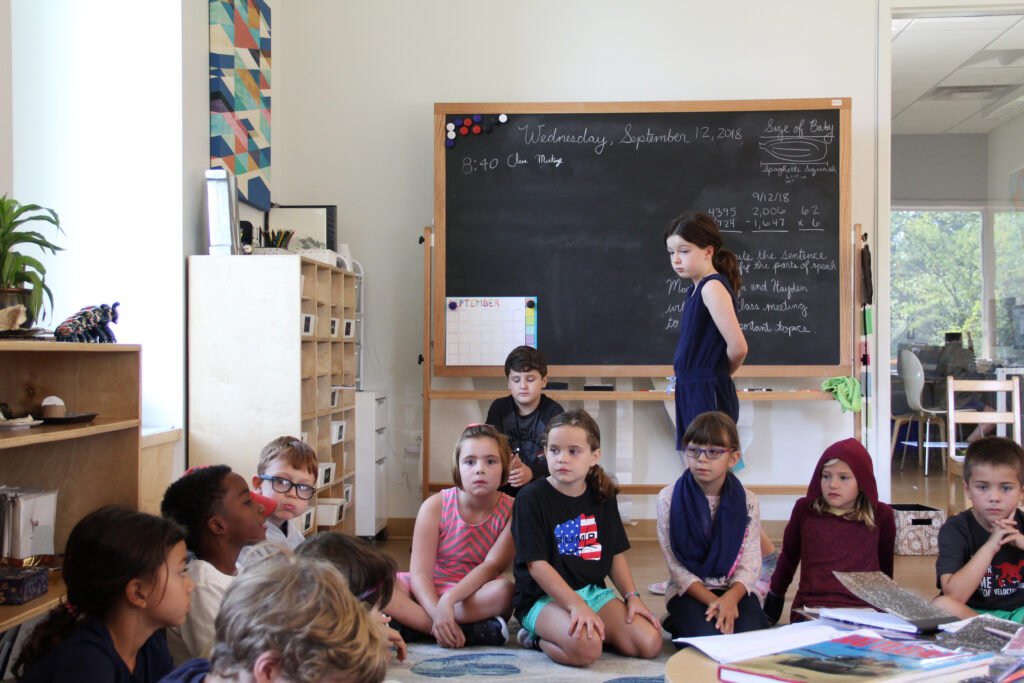 As expected, the first few meetings were a little bumpy, but as the students practiced working with the notebook items and the agenda and each of the different roles, they have become more skilled. Class meetings run smoothly now, and everyone knows what is expected.
As expected, the first few meetings were a little bumpy, but as the students practiced working with the notebook items and the agenda and each of the different roles, they have become more skilled. Class meetings run smoothly now, and everyone knows what is expected.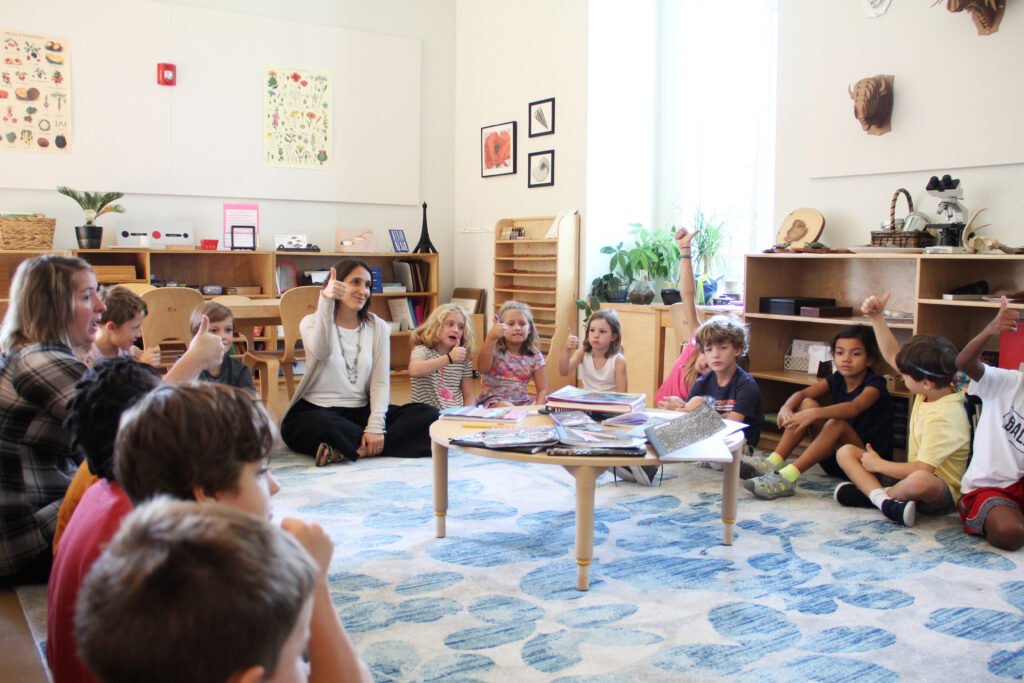 After the meeting, the meeting notes and agenda are placed back into the binder, as a public record for the entire community. Should anyone forget what was decided, they can check.
After the meeting, the meeting notes and agenda are placed back into the binder, as a public record for the entire community. Should anyone forget what was decided, they can check.


 We are so lucky that our campus allows for sledding! Elementary children bring their sleds and take off with their friends on our (moderate!) hill.
We are so lucky that our campus allows for sledding! Elementary children bring their sleds and take off with their friends on our (moderate!) hill.
 A first year child's first experience of this Elementary privilege.
A first year child's first experience of this Elementary privilege. There are outdoor attire rules... I'm guessing the child's hood just flew off mid-sledding...
There are outdoor attire rules... I'm guessing the child's hood just flew off mid-sledding...



 Teamwork makes the dream work!
Teamwork makes the dream work! Recess is, of course, fun and provides lots of time for the gross motor movement and is so great for children. But, this movement is not limited to recess, and the snow and cold doesn't stop the children from getting their work done.
Recess is, of course, fun and provides lots of time for the gross motor movement and is so great for children. But, this movement is not limited to recess, and the snow and cold doesn't stop the children from getting their work done. "The child’s instinct confirms the fact that work is an inherent tendency in human nature; it is the characteristic instinct of the human race.” -Dr. MontessoriLet me once again proclaim the photographic brilliance of Melinda Smith! Thank you, Melinda!
"The child’s instinct confirms the fact that work is an inherent tendency in human nature; it is the characteristic instinct of the human race.” -Dr. MontessoriLet me once again proclaim the photographic brilliance of Melinda Smith! Thank you, Melinda!
 Tuesday and Wednesday of last week Villa di Maria was fortunate to host actor Erika Roberts from the Missouri History Museum's ACTivist program. She graced us with four sessions individually tailored toward our Extended Day through Upper Elementary children. She subtly shifted the depth of each presentation based on the age of the children.The session began with discussion and acceptance of Brave Space Rules, including refraining from assuming other people's thoughts or feelings and using "I statements" when speaking.
Tuesday and Wednesday of last week Villa di Maria was fortunate to host actor Erika Roberts from the Missouri History Museum's ACTivist program. She graced us with four sessions individually tailored toward our Extended Day through Upper Elementary children. She subtly shifted the depth of each presentation based on the age of the children.The session began with discussion and acceptance of Brave Space Rules, including refraining from assuming other people's thoughts or feelings and using "I statements" when speaking.
 Erika then moved the students on to a discussion around rights, particularly civil rights. The ACTivist program defines rights as "things that we are all allowed, or should all be allowed, to do. Rights are important for human beings to have to make sure we are happy and healthy and treated fairly." The children deftly identified some of their own rights and Erika adeptly clarified the distinction between rights and privileges. The next step was to define civil rights, this narrowing led civil rights being defined as "the rights that we have because we’re American citizens." Throughout the presentation she continually engaged the children in the conversation which both engaged them and let her know the depth of their understanding. She asked children to identify ideas and events they didn’t know and used this as an opportunity for further exploration.
Erika then moved the students on to a discussion around rights, particularly civil rights. The ACTivist program defines rights as "things that we are all allowed, or should all be allowed, to do. Rights are important for human beings to have to make sure we are happy and healthy and treated fairly." The children deftly identified some of their own rights and Erika adeptly clarified the distinction between rights and privileges. The next step was to define civil rights, this narrowing led civil rights being defined as "the rights that we have because we’re American citizens." Throughout the presentation she continually engaged the children in the conversation which both engaged them and let her know the depth of their understanding. She asked children to identify ideas and events they didn’t know and used this as an opportunity for further exploration. The conversation on civil rights naturally led to discussion of instances in which civil rights are not respected. The children brainstormed how it would feel to have one's right removed and what they might do in a situation where their rights were infringed upon. This introduced a thoughtful discussion of why people make the choices they make to defend their, or others', rights.
The conversation on civil rights naturally led to discussion of instances in which civil rights are not respected. The children brainstormed how it would feel to have one's right removed and what they might do in a situation where their rights were infringed upon. This introduced a thoughtful discussion of why people make the choices they make to defend their, or others', rights. In full Montessori fashion, Erika came with a timeline of African American civil rights from 1803-present, which included national and St. Louis-specific events. It was encouraging to witness the Upper Elementary children comment on Dred and Harriet Scott's case which they were all familiar with from past studies.
In full Montessori fashion, Erika came with a timeline of African American civil rights from 1803-present, which included national and St. Louis-specific events. It was encouraging to witness the Upper Elementary children comment on Dred and Harriet Scott's case which they were all familiar with from past studies.
 The session concluded in a performance piece which involved song and storytelling at its finest. The children were captivated by the actor's portrayal of the life of Lucy Delaney. Even the youngest children understood the essence of the story is of a young woman's quest for freedom. The Missouri History Museum's program is fantastic, and our children benefited from taking part in such thoughtfully planned and skillfully executed event. Classrooms are further building on this experience and encouraging children’s curiosity through books and research projects.
The session concluded in a performance piece which involved song and storytelling at its finest. The children were captivated by the actor's portrayal of the life of Lucy Delaney. Even the youngest children understood the essence of the story is of a young woman's quest for freedom. The Missouri History Museum's program is fantastic, and our children benefited from taking part in such thoughtfully planned and skillfully executed event. Classrooms are further building on this experience and encouraging children’s curiosity through books and research projects. For those interested, here is a description of the historical figure that was portrayed for the children: Lucy Ann Delaney, born Lucy Berry (c. 1830 – after 1891), was an African-American author, former slave, and activist, notable for her 1891 narrative From the Darkness Cometh the Light, or, Struggles for Freedom. This is the only first-person account of a "freedom suit" and one of the few post-Emancipation published slave narratives.The memoir recounts her mother Polly Berry's legal battles in St. Louis, Missouri for her own and her daughter's freedom from slavery. For her daughter's case, Berry attracted the support of Edward Bates, a prominent Whig politician and judge, and the future US Attorney General under President Abraham Lincoln. He argued the case of Lucy Ann Berry in court and won in February 1844. Their cases were two of 301 freedom suits filed in St. Louis from 1814 to 1860. Discovered in the late twentieth century, the case files are held by the Missouri Historical Society.
For those interested, here is a description of the historical figure that was portrayed for the children: Lucy Ann Delaney, born Lucy Berry (c. 1830 – after 1891), was an African-American author, former slave, and activist, notable for her 1891 narrative From the Darkness Cometh the Light, or, Struggles for Freedom. This is the only first-person account of a "freedom suit" and one of the few post-Emancipation published slave narratives.The memoir recounts her mother Polly Berry's legal battles in St. Louis, Missouri for her own and her daughter's freedom from slavery. For her daughter's case, Berry attracted the support of Edward Bates, a prominent Whig politician and judge, and the future US Attorney General under President Abraham Lincoln. He argued the case of Lucy Ann Berry in court and won in February 1844. Their cases were two of 301 freedom suits filed in St. Louis from 1814 to 1860. Discovered in the late twentieth century, the case files are held by the Missouri Historical Society. This blog post would not be as rich without the help of Jade Venditte. Jade, thanks for sharing information, giving insightful feedback and bringing this presentation to our community.The pictures which truly help capture the presentation are thanks to the ever talented Melinda Smith.
This blog post would not be as rich without the help of Jade Venditte. Jade, thanks for sharing information, giving insightful feedback and bringing this presentation to our community.The pictures which truly help capture the presentation are thanks to the ever talented Melinda Smith.







































 Practical Life constitutes some of the first lessons that children are given in the Children’s House. The children are drawn to this type of work. Even if the form is different, these lessons are fundamentally connected to the work they see the adults in their lives engaging in.
Practical Life constitutes some of the first lessons that children are given in the Children’s House. The children are drawn to this type of work. Even if the form is different, these lessons are fundamentally connected to the work they see the adults in their lives engaging in.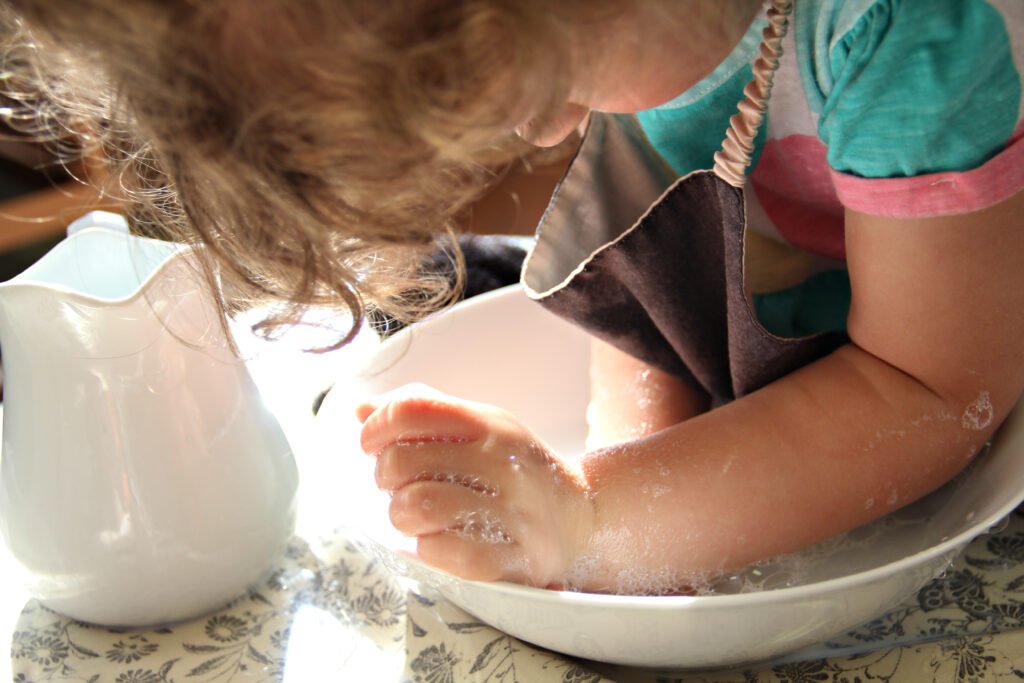 Practical Life is the work of independence. It begins at home with dressing oneself, putting on one's shoes, feeding oneself. In the Children's House the child is given the opportunity to grow these skills.
Practical Life is the work of independence. It begins at home with dressing oneself, putting on one's shoes, feeding oneself. In the Children's House the child is given the opportunity to grow these skills.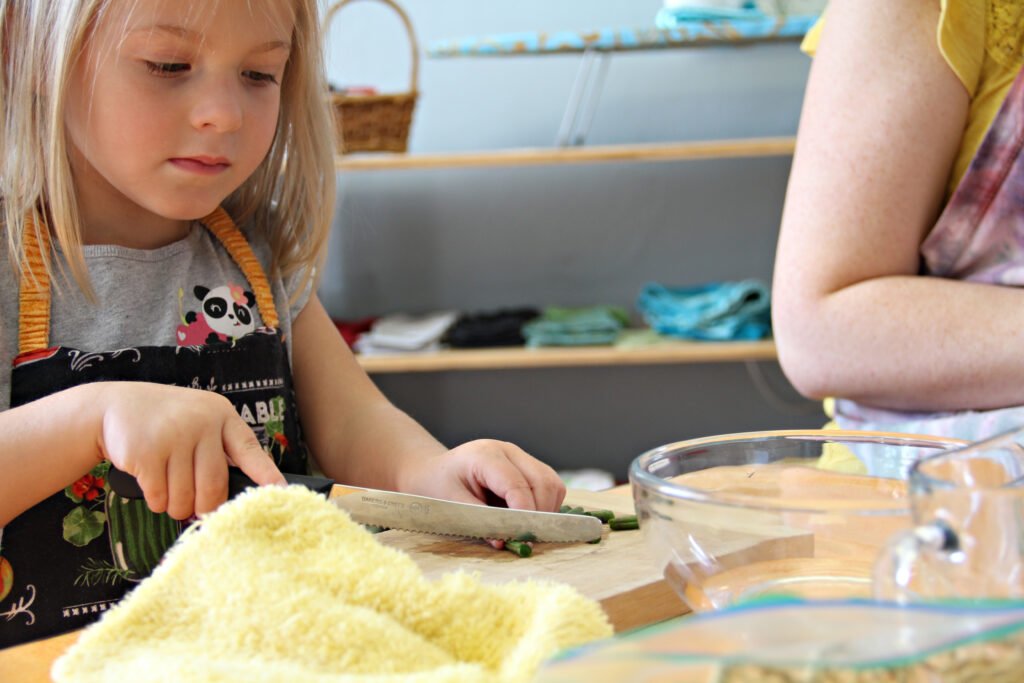 How beautiful it is to see young children washing their hands, scrubbing tables and cutting vegetables. There is an inherent goodness to these activities. The work is purposeful and consuming; the outcome is measurable and satisfying; the children, as a result, are calm and centered.Practical Life work expands as the child turns from activities centered around the care of the self (e.g., Hand Washing) to those that encompass the care of the environment (e.g., Table Washing, Sweeping). As young children more firmly develop their sense of self and begin to master those skills which enable them to take care of themselves, they can broaden their focus to include the world outside of themselves. Their interest in the environment is met with Practical Life work which involves them in the care of their surroundings. This is done in a way that builds their sense of ownership of the classroom as well as their role in the community
How beautiful it is to see young children washing their hands, scrubbing tables and cutting vegetables. There is an inherent goodness to these activities. The work is purposeful and consuming; the outcome is measurable and satisfying; the children, as a result, are calm and centered.Practical Life work expands as the child turns from activities centered around the care of the self (e.g., Hand Washing) to those that encompass the care of the environment (e.g., Table Washing, Sweeping). As young children more firmly develop their sense of self and begin to master those skills which enable them to take care of themselves, they can broaden their focus to include the world outside of themselves. Their interest in the environment is met with Practical Life work which involves them in the care of their surroundings. This is done in a way that builds their sense of ownership of the classroom as well as their role in the community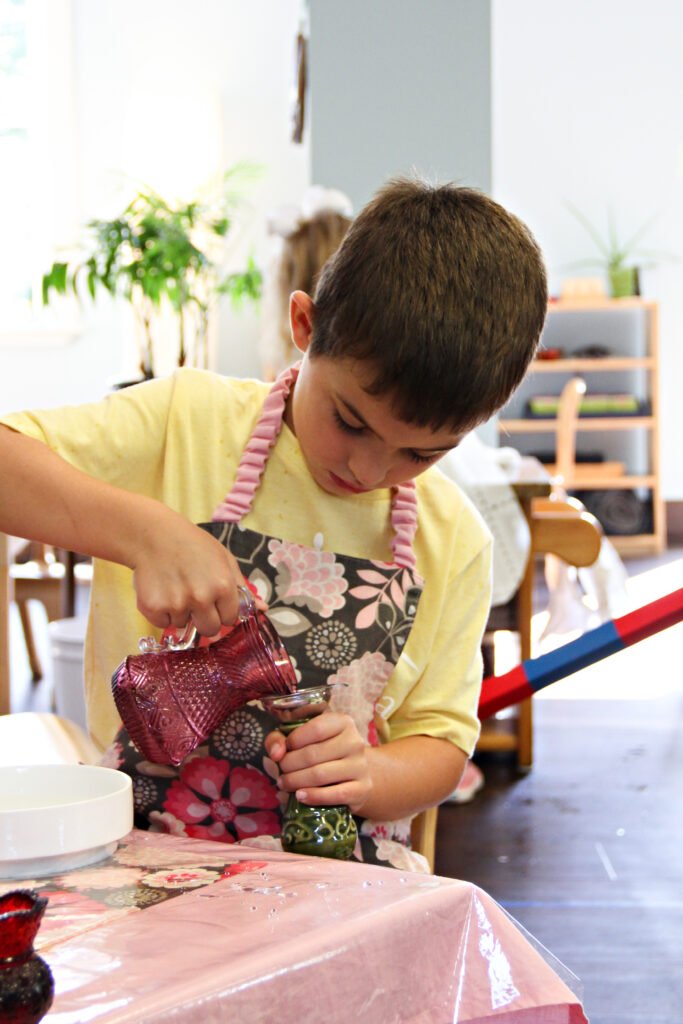 In Practical Life exercises such as flower arranging and ironing, the child’s care for the environment goes beyond necessities such as cleaning and food preparation and incorporates the beautification of the environment.
In Practical Life exercises such as flower arranging and ironing, the child’s care for the environment goes beyond necessities such as cleaning and food preparation and incorporates the beautification of the environment.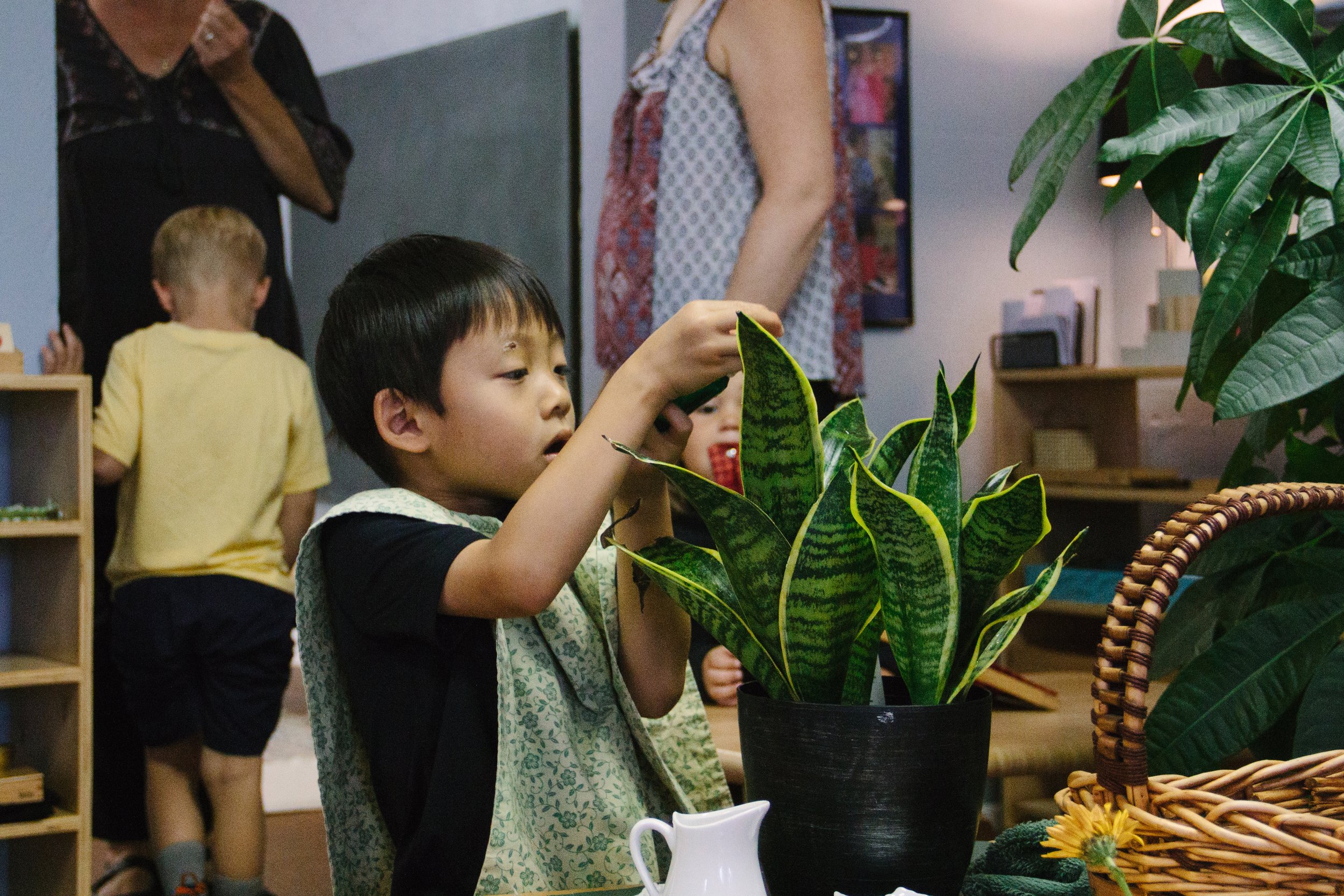 Practical Life does not end in the Children's House. It continues to develop as the child’s relationship to their environment changes. Throughout the year we’ll delve deeper into the many aspects of Practical Life and examine how it evolves as the children move on to Elementary.Thanks as always to fabulously talented Melinda Smith for her photographic skills.
Practical Life does not end in the Children's House. It continues to develop as the child’s relationship to their environment changes. Throughout the year we’ll delve deeper into the many aspects of Practical Life and examine how it evolves as the children move on to Elementary.Thanks as always to fabulously talented Melinda Smith for her photographic skills.


 From Lower Elementary Guide Ms. Megan's description of committee meetings, it's easy to see how many social (read: life!) skills the children gain from this experience. She shares, "If you were to sit and observe a committee meeting, you would see charts, maps, surveys and graphs. You would not only hear the children's thoughts and ideas, but persuasive arguments, disputes, negotiations and compromises. You would get a sense of how deeply responsible the children feel about their individual tasks and how eager they are to contribute to their small society. Watching the community come together through this activity is inspiring!"
From Lower Elementary Guide Ms. Megan's description of committee meetings, it's easy to see how many social (read: life!) skills the children gain from this experience. She shares, "If you were to sit and observe a committee meeting, you would see charts, maps, surveys and graphs. You would not only hear the children's thoughts and ideas, but persuasive arguments, disputes, negotiations and compromises. You would get a sense of how deeply responsible the children feel about their individual tasks and how eager they are to contribute to their small society. Watching the community come together through this activity is inspiring!"






 Thank you Melinda for the photos!
Thank you Melinda for the photos!
 If you haven’t already come up with your favorite way to answer those questions about what Montessori is and what makes Montessori unique, here’s a great way to answer: observation.
If you haven’t already come up with your favorite way to answer those questions about what Montessori is and what makes Montessori unique, here’s a great way to answer: observation. Dr. Montessori did not impose a method which happened to work. Rather, her pedagogy arose from her continued observation of children. She noticed which materials the children were drawn to and what type of work they wanted to do. The brilliance she gifted us with is a result of her skilled observation.
Dr. Montessori did not impose a method which happened to work. Rather, her pedagogy arose from her continued observation of children. She noticed which materials the children were drawn to and what type of work they wanted to do. The brilliance she gifted us with is a result of her skilled observation.
 Observation remains the foundational piece of implementing Montessori in the classroom. Through observation the guide gets to know the child and determines how best to link them with the environment. Through purposeful and conscientious noticing, the guide is able to offer the right lesson at just the right time. This in turn leads to repetition,
Observation remains the foundational piece of implementing Montessori in the classroom. Through observation the guide gets to know the child and determines how best to link them with the environment. Through purposeful and conscientious noticing, the guide is able to offer the right lesson at just the right time. This in turn leads to repetition,  As the school year progresses and the children are settling into their environments, parents are invited to get in on the magic by observing in the classroom. This opportunity is an essential part of parent education and a great avenue toward understanding your child’s classroom experience. Observing is also the best way to prepare yourself for parent-teacher conferences!
As the school year progresses and the children are settling into their environments, parents are invited to get in on the magic by observing in the classroom. This opportunity is an essential part of parent education and a great avenue toward understanding your child’s classroom experience. Observing is also the best way to prepare yourself for parent-teacher conferences! Here are some things to look for and/or keep in mind when you observe:
Here are some things to look for and/or keep in mind when you observe:
 Observation is what allows Montessori to come alive. Please come and join us in the classroom!(Isn't Melinda Smith just amazing with her camera? Thank you Melinda!)
Observation is what allows Montessori to come alive. Please come and join us in the classroom!(Isn't Melinda Smith just amazing with her camera? Thank you Melinda!)
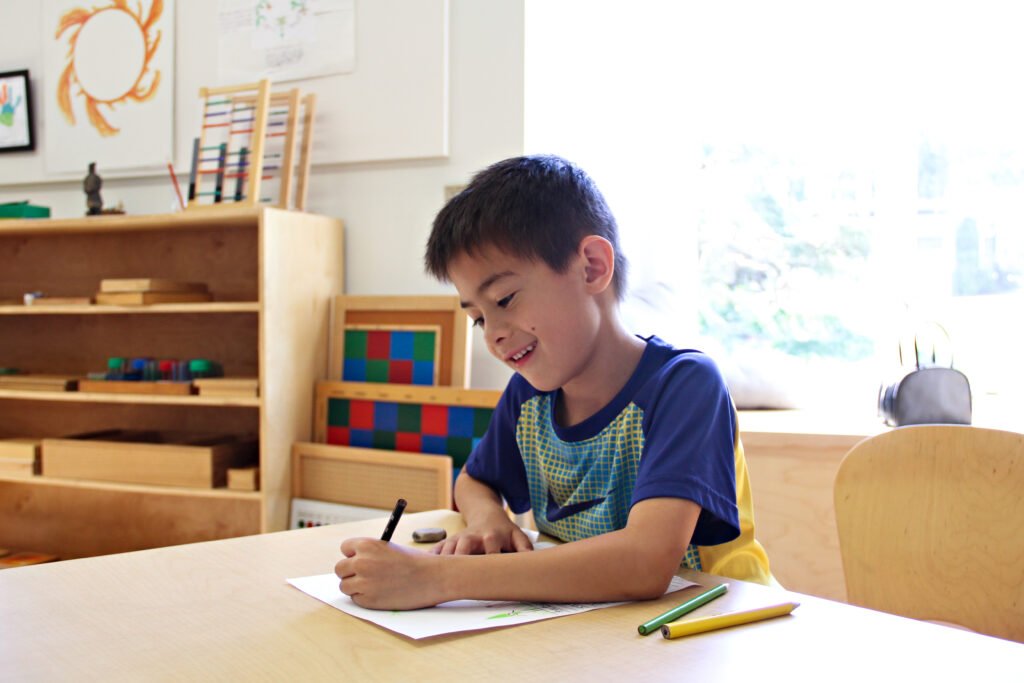 “The first essential for the child's development is concentration. The child who concentrates is immensely happy.”
“The first essential for the child's development is concentration. The child who concentrates is immensely happy.” Montessori environments inherently bolster the development of concentration. The three-hour work period affords extended time without interruption which is vital for concentration to thrive. Further, the materials themselves are attractive to the children, inviting repetition which in turn leads to concentration.
Montessori environments inherently bolster the development of concentration. The three-hour work period affords extended time without interruption which is vital for concentration to thrive. Further, the materials themselves are attractive to the children, inviting repetition which in turn leads to concentration.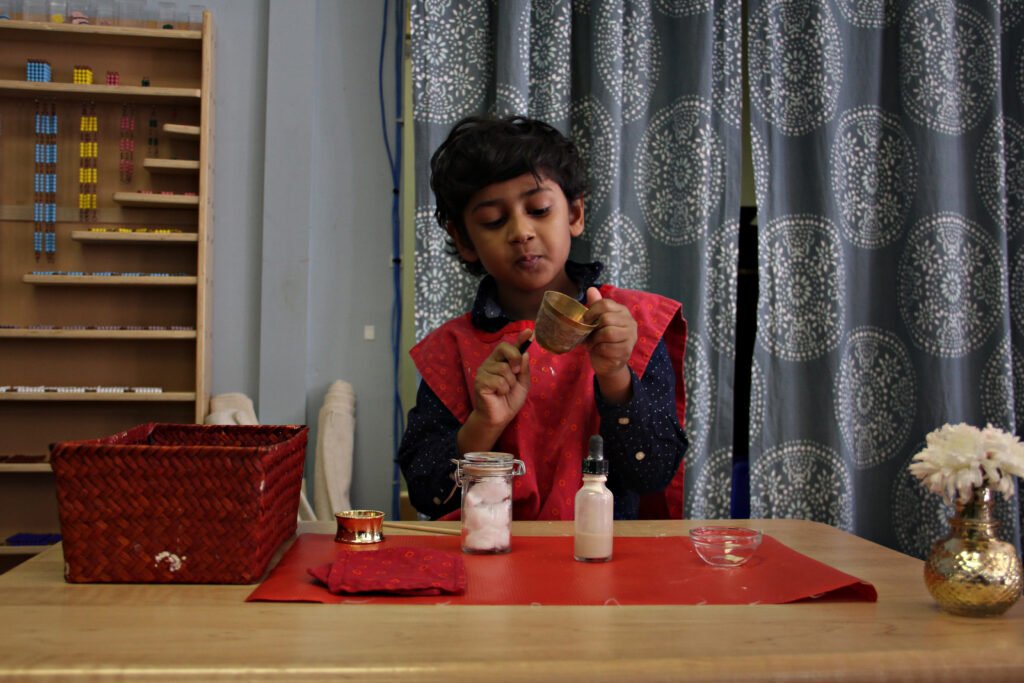
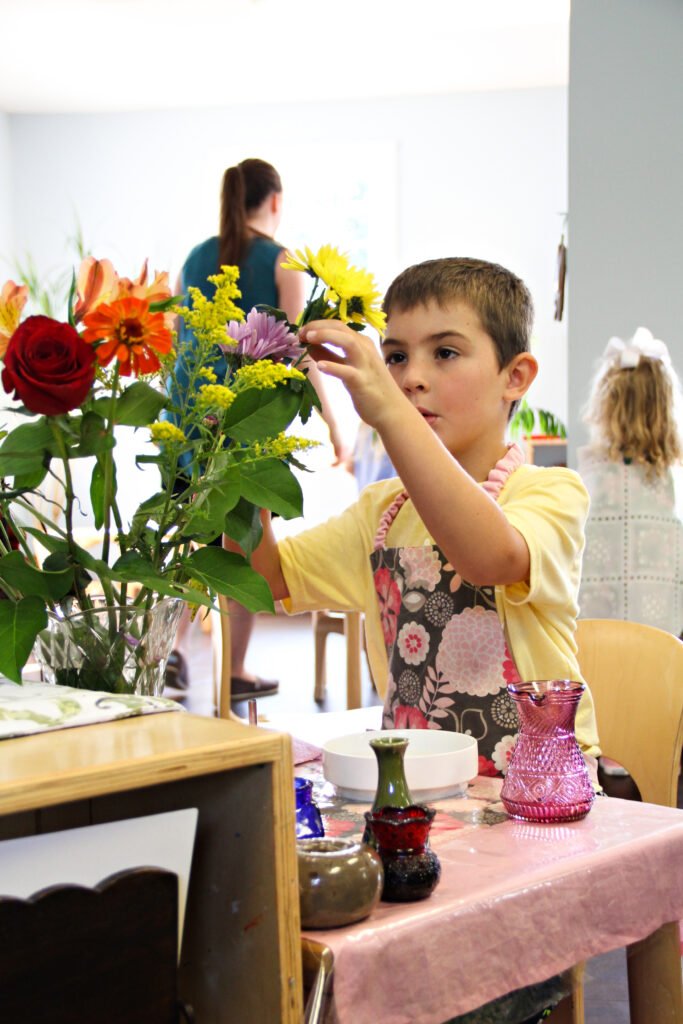 As is true at school, when your child is concentrating on meaningful work at home, please do not interrupt them unless absolutely necessary. Their work may not seem meaningful to adult eyes, but balancing playing cards, tying and untying bows, lining up all the shoes in the house... This is all meaningful work.
As is true at school, when your child is concentrating on meaningful work at home, please do not interrupt them unless absolutely necessary. Their work may not seem meaningful to adult eyes, but balancing playing cards, tying and untying bows, lining up all the shoes in the house... This is all meaningful work.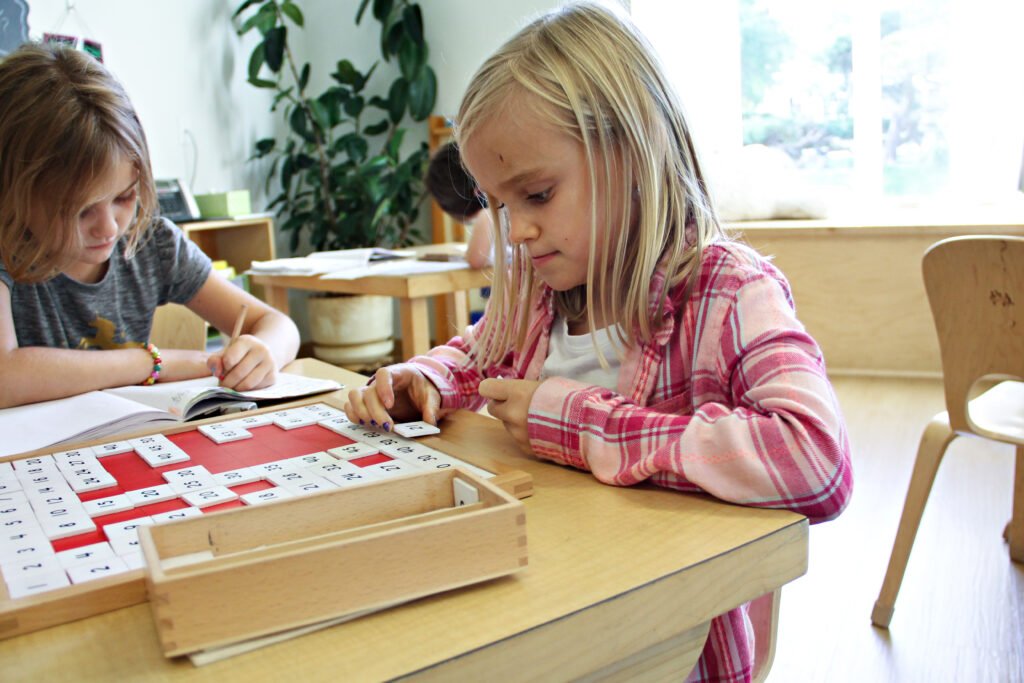 The sight of a child concentrating can transport us. We sense the feeling of deep calm and focus we too experience when we are allowed to fully lose ourselves to a productive task. Concentration is a beautiful thing to witness. Here we are witnesses to the moment of learning, the acquisition of knowledge.
The sight of a child concentrating can transport us. We sense the feeling of deep calm and focus we too experience when we are allowed to fully lose ourselves to a productive task. Concentration is a beautiful thing to witness. Here we are witnesses to the moment of learning, the acquisition of knowledge.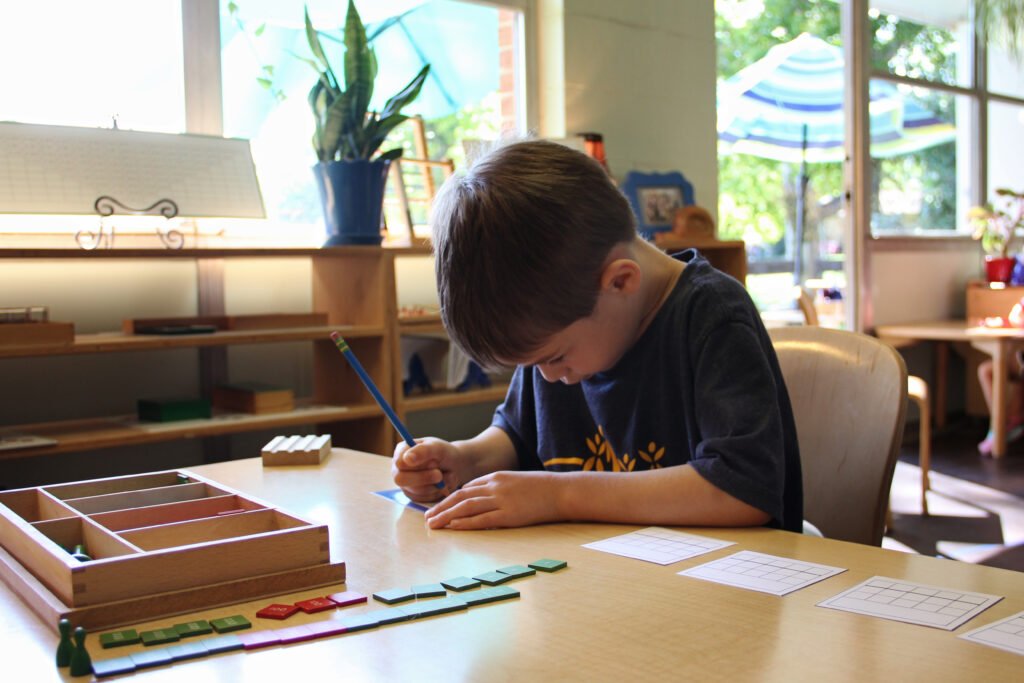 Many thanks to Melinda Smith for sharing her splendid photography.
Many thanks to Melinda Smith for sharing her splendid photography.

 There can be as many ways to do this as there are classrooms of elementary children, but a few helpful principles that guides may often use are:
There can be as many ways to do this as there are classrooms of elementary children, but a few helpful principles that guides may often use are:
 The process will be both similar and different each year. This year, when I asked the children why we might want to phrase things positively instead of negatively, one mischievous-eyed child shared, “Because when someone tells you you can’t do something, it just makes you want to do it more.” Early wisdom, from a child who has - perhaps - had many experiences already being told what they couldn’t do, and far fewer being encouraged in what they can do. Imagine how helpful it might be to give this child options instead of restrictions! The rules (or guidelines, or contract, it can be called whatever the children are comfortable with) can present a roadmap to help the children be their best selves instead of a series of roadblocks preventing them from progress.
The process will be both similar and different each year. This year, when I asked the children why we might want to phrase things positively instead of negatively, one mischievous-eyed child shared, “Because when someone tells you you can’t do something, it just makes you want to do it more.” Early wisdom, from a child who has - perhaps - had many experiences already being told what they couldn’t do, and far fewer being encouraged in what they can do. Imagine how helpful it might be to give this child options instead of restrictions! The rules (or guidelines, or contract, it can be called whatever the children are comfortable with) can present a roadmap to help the children be their best selves instead of a series of roadblocks preventing them from progress.
 In an upcoming post we will cover class meetings, one of the tools for amending, expanding and revisiting the social contract made together at the start. In part three, we will talk about how you can include and empower your child in your family life at home (spoiler: it’s the weekly family meeting).Many thanks to Melinda Smith and Jade Venditte for the photographs.
In an upcoming post we will cover class meetings, one of the tools for amending, expanding and revisiting the social contract made together at the start. In part three, we will talk about how you can include and empower your child in your family life at home (spoiler: it’s the weekly family meeting).Many thanks to Melinda Smith and Jade Venditte for the photographs.
 Like most things in the Montessori classroom, lunch is a multi-faceted opportunity for growth. It provides occasions for choice making, self-sufficiency and increasing hand strength and dexterity. It’s a time to practice social graces, build community and learn table manners. Our work at home regarding lunch preparation can feed this work in the classroom, allowing the children to get the most out of mealtime at school.
Like most things in the Montessori classroom, lunch is a multi-faceted opportunity for growth. It provides occasions for choice making, self-sufficiency and increasing hand strength and dexterity. It’s a time to practice social graces, build community and learn table manners. Our work at home regarding lunch preparation can feed this work in the classroom, allowing the children to get the most out of mealtime at school.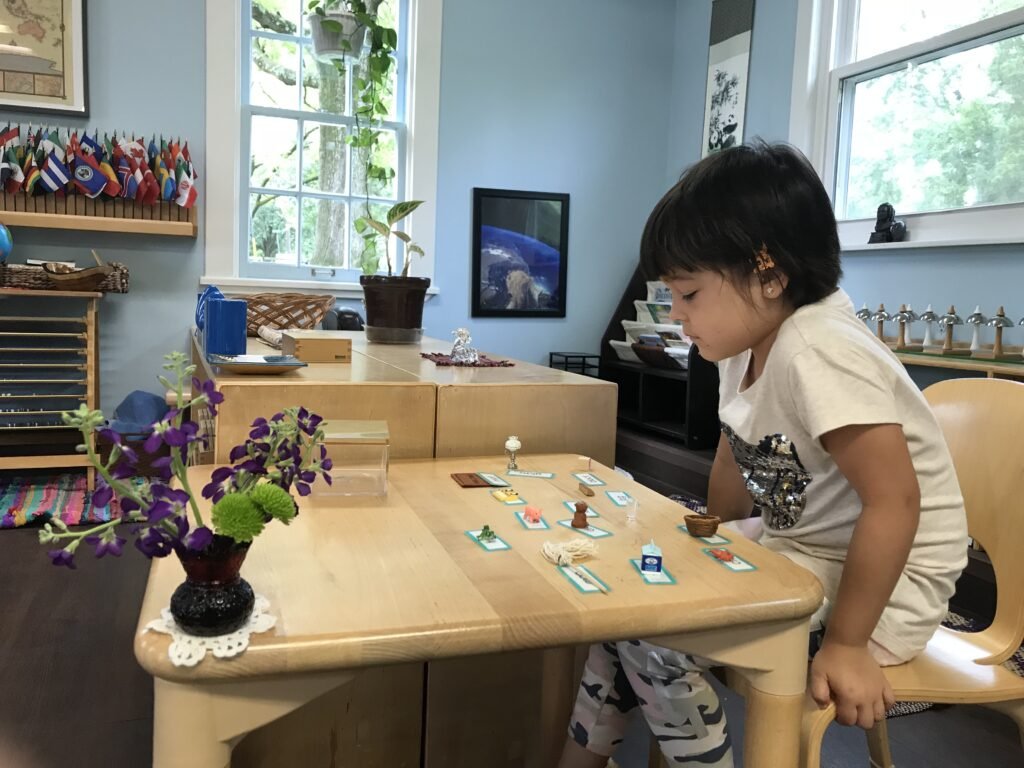 When thinking about lunches, we must keep in mind how much our children work while they are at school. The youngest are building their personalities, refining their movement, expanding their language and working with numbers. Elementary children are figuring out their social selves and actively pursuing new learning.After a three-hour work period, children need to replenish their energy with a healthy lunch. Extended day and elementary children need their lunch to provide the nourishment for their afternoon work.While we've all had the occasional day where we pretend that the cheese flavoring in the bag of Doritos counts as protein and fruit snacks are actually fruit, we also know this has to be the exception rather than the rule in order for our children to have what they need at to thrive at school.In the Children’s House a protein, fruit and vegetable will suffice for most children. Elementary children will likely need larger portions; figuring out how much they need is a conversation you can have with your child at the end of the day. (Strategies and tips about the actual packing of lunches coming soon!)While adjusting the choices available for lunch, school can be an excuse to deflect pushback. “This is what <insert name of teacher> said…” goes a long way. Use it sparingly and use it wisely, but if you need extra support packing a lunch full of healthy options, this might be one of those moments.
When thinking about lunches, we must keep in mind how much our children work while they are at school. The youngest are building their personalities, refining their movement, expanding their language and working with numbers. Elementary children are figuring out their social selves and actively pursuing new learning.After a three-hour work period, children need to replenish their energy with a healthy lunch. Extended day and elementary children need their lunch to provide the nourishment for their afternoon work.While we've all had the occasional day where we pretend that the cheese flavoring in the bag of Doritos counts as protein and fruit snacks are actually fruit, we also know this has to be the exception rather than the rule in order for our children to have what they need at to thrive at school.In the Children’s House a protein, fruit and vegetable will suffice for most children. Elementary children will likely need larger portions; figuring out how much they need is a conversation you can have with your child at the end of the day. (Strategies and tips about the actual packing of lunches coming soon!)While adjusting the choices available for lunch, school can be an excuse to deflect pushback. “This is what <insert name of teacher> said…” goes a long way. Use it sparingly and use it wisely, but if you need extra support packing a lunch full of healthy options, this might be one of those moments.
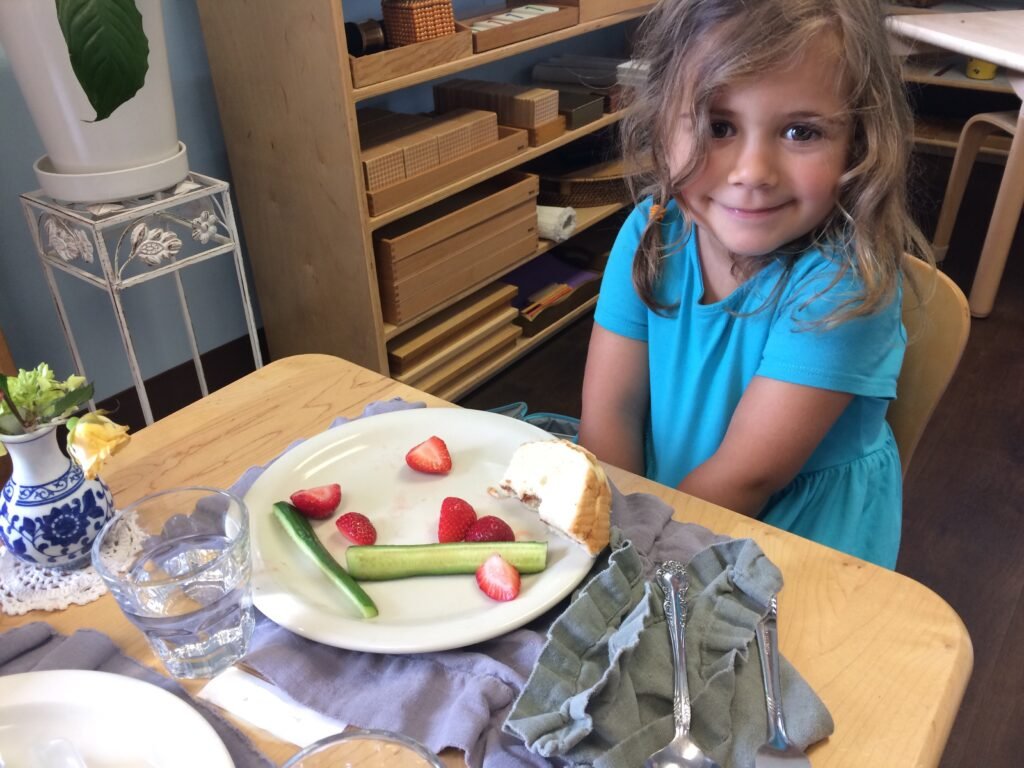 Photo credit: Jessie Braud
Photo credit: Jessie Braud

 We are so excited that 2018-2019 is officially underway!
We are so excited that 2018-2019 is officially underway! Five minutes into the school year and the outdoor environment was in full swing! What better place to do watercolor painting than out in the sunshine.
Five minutes into the school year and the outdoor environment was in full swing! What better place to do watercolor painting than out in the sunshine. The children wasted no time connecting with nature and caring for their environment.
The children wasted no time connecting with nature and caring for their environment. Welcome back fort builders!
Welcome back fort builders! From the very beginning, we end our day with jobs. Taking out the trash and recycling gives the children the opportunity to contribute to the whole community.Here's to a fabulous year!
From the very beginning, we end our day with jobs. Taking out the trash and recycling gives the children the opportunity to contribute to the whole community.Here's to a fabulous year!
 The prepared environment is central to Montessori theory and crucial to its practice. Each environment is specially designed to meet the needs of the children who occupy it. Our guides, assistants and staff have been working tirelessly to prepare each of our environments for the children. And we cannot wait for them to come!
The prepared environment is central to Montessori theory and crucial to its practice. Each environment is specially designed to meet the needs of the children who occupy it. Our guides, assistants and staff have been working tirelessly to prepare each of our environments for the children. And we cannot wait for them to come! In preparing the environments, guides have taken into consideration everything from the sequence of the materials to the natural light in the room. They have contemplated daily routines, how the children will move through the room, and placement of artwork. Each decision was made while holding central the needs of the children.
In preparing the environments, guides have taken into consideration everything from the sequence of the materials to the natural light in the room. They have contemplated daily routines, how the children will move through the room, and placement of artwork. Each decision was made while holding central the needs of the children. It is not just the physical space which has been prepared. The guides, assistants and staff have also been preparing themselves through the summer and over the past few weeks in particular.
It is not just the physical space which has been prepared. The guides, assistants and staff have also been preparing themselves through the summer and over the past few weeks in particular. Preparation of the adult is an ongoing process. It requires self-reflection and conscious work so that we offer the best of ourselves to the children. Self-preparation takes many different routes. Some read books, some catch up on much needed self-care, some attend lectures or workshops. As a whole, the staff has engaged in anti-bias, anti-racist training. All of this work is to bring our best selves to your children.
Preparation of the adult is an ongoing process. It requires self-reflection and conscious work so that we offer the best of ourselves to the children. Self-preparation takes many different routes. Some read books, some catch up on much needed self-care, some attend lectures or workshops. As a whole, the staff has engaged in anti-bias, anti-racist training. All of this work is to bring our best selves to your children. Our guides do not model perfection but rather curiosity, kindness, and a friendliness toward error which results in true learning and resiliency. Guides model human beings who choose to walk on the path toward reaching their potential. This is the very path on which we invite the children to join us. It’s the path we lay for them by preparing the environment.
Our guides do not model perfection but rather curiosity, kindness, and a friendliness toward error which results in true learning and resiliency. Guides model human beings who choose to walk on the path toward reaching their potential. This is the very path on which we invite the children to join us. It’s the path we lay for them by preparing the environment. Welcome and welcome back!All photography is thanks to Melinda Smith.
Welcome and welcome back!All photography is thanks to Melinda Smith.